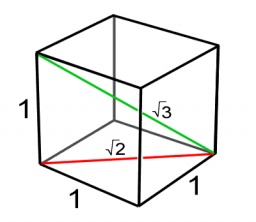Ratio of edges
The cuboid dimensions are in a ratio of 3:1:2. The body diagonal has a length of 28 cm. Find the volume of a cuboid.
Final Answer:

Tips for related online calculators
Check out our ratio calculator.
Do you have a linear equation or system of equations and are looking for its solution? Or do you have a quadratic equation?
Tip: Our volume units converter will help you convert volume units.
See also our right triangle calculator.
See also our trigonometric triangle calculator.
Do you have a linear equation or system of equations and are looking for its solution? Or do you have a quadratic equation?
Tip: Our volume units converter will help you convert volume units.
See also our right triangle calculator.
See also our trigonometric triangle calculator.
You need to know the following knowledge to solve this word math problem:
algebrasolid geometryplanimetricsbasic operations and conceptsUnits of physical quantitiesGrade of the word problem
Related math problems and questions:
- Cuboid diagonals
 The cuboid has dimensions of 15, 20, and 40 cm. Calculate its volume and surface, the length of the body diagonal, and the lengths of all three wall diagonals.
The cuboid has dimensions of 15, 20, and 40 cm. Calculate its volume and surface, the length of the body diagonal, and the lengths of all three wall diagonals. - Body diagonal
 Calculate the volume of a cuboid whose body diagonal u equals 6.1 cm. The rectangular base has dimensions of 3.2 cm and 2.4 cm.
Calculate the volume of a cuboid whose body diagonal u equals 6.1 cm. The rectangular base has dimensions of 3.2 cm and 2.4 cm. - Wall and body diagonals
 The block/cuboid has dimensions a = 4cm, b = 3cm, and c = 12cm. Calculate the length of the wall and body diagonals.
The block/cuboid has dimensions a = 4cm, b = 3cm, and c = 12cm. Calculate the length of the wall and body diagonals. - Dimensions 4703
 The block has dimensions l = 5 cm, w = 4 cm, and h = 3 cm. Calculate the length of its body diagonal.
The block has dimensions l = 5 cm, w = 4 cm, and h = 3 cm. Calculate the length of its body diagonal. - Dimensions 6264
 Calculate the length of the body diagonal of a block whose dimensions are a = 5cm, b = 6cm, c = 10cm.
Calculate the length of the body diagonal of a block whose dimensions are a = 5cm, b = 6cm, c = 10cm. - Body diagonal
 Calculate the length of the body diagonal of a block with dimensions: a = 20 cm, b = 30 cm, c = 15 cm.
Calculate the length of the body diagonal of a block with dimensions: a = 20 cm, b = 30 cm, c = 15 cm. - Cuboid easy
 The cuboid has the dimensions a = 12 cm, b = 9 cm, c = 36 cm. Calculate the length of the body diagonal of the cuboid.
The cuboid has the dimensions a = 12 cm, b = 9 cm, c = 36 cm. Calculate the length of the body diagonal of the cuboid.
